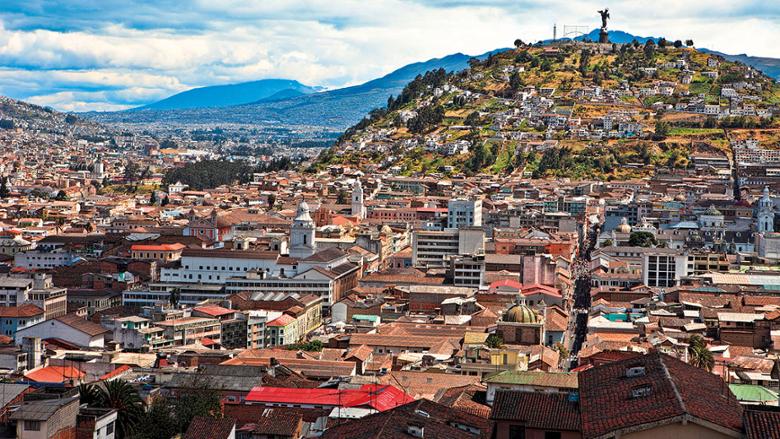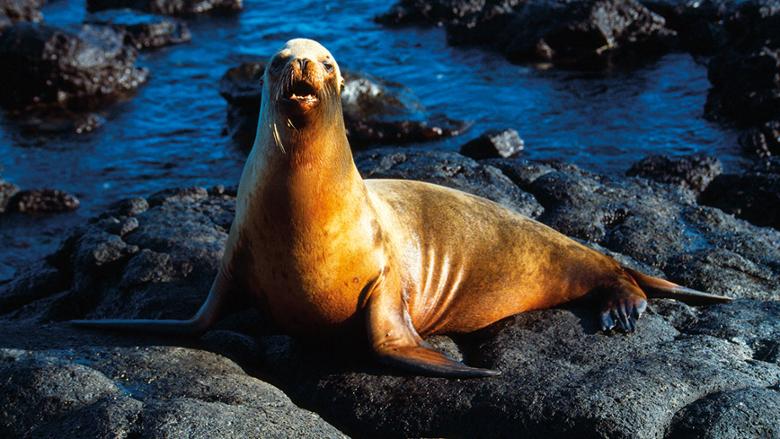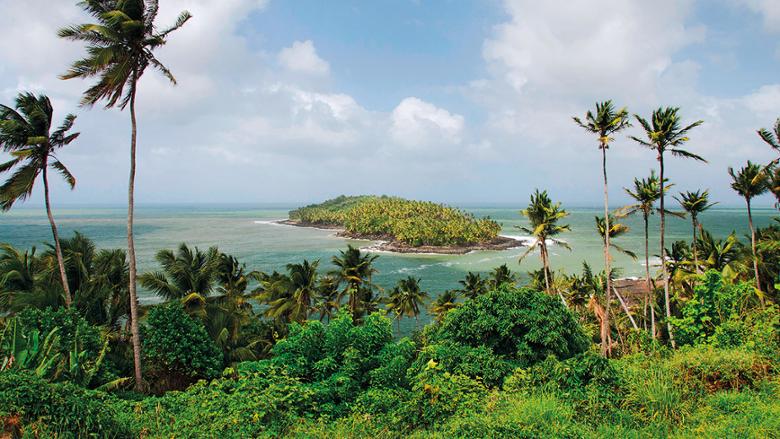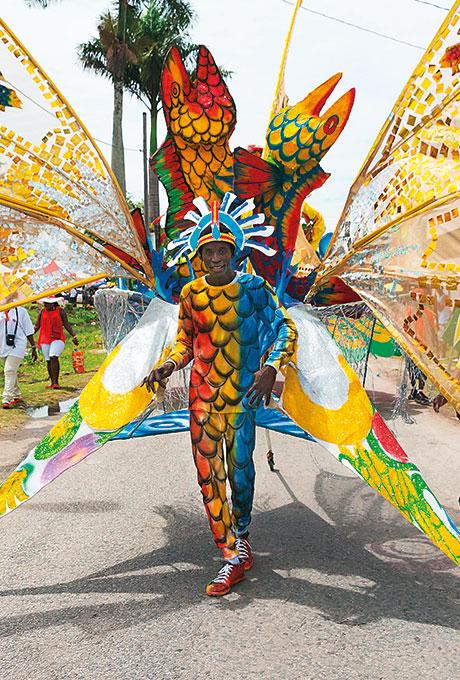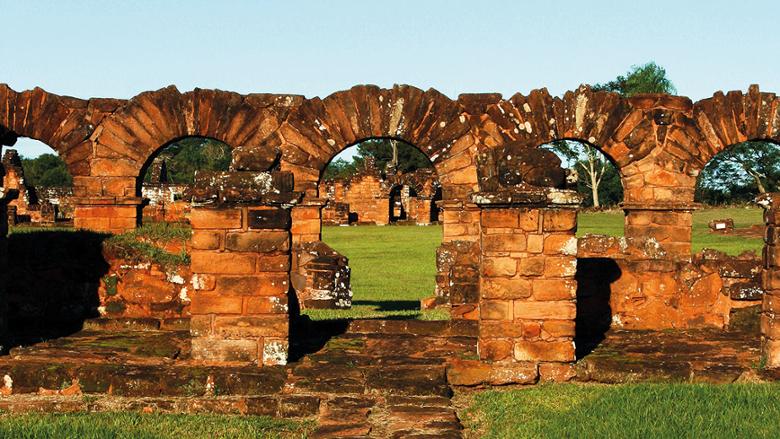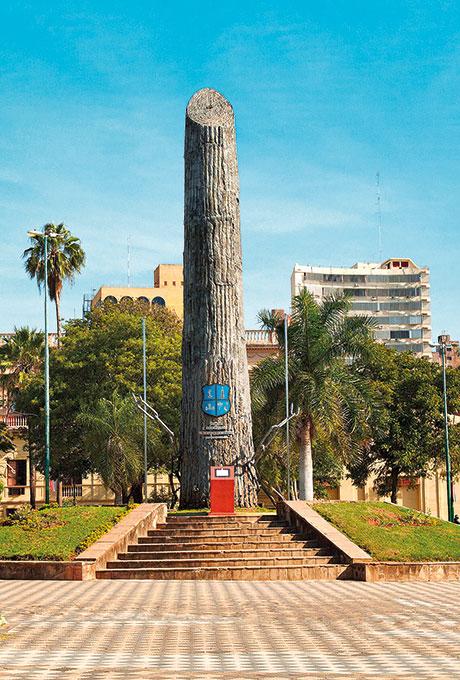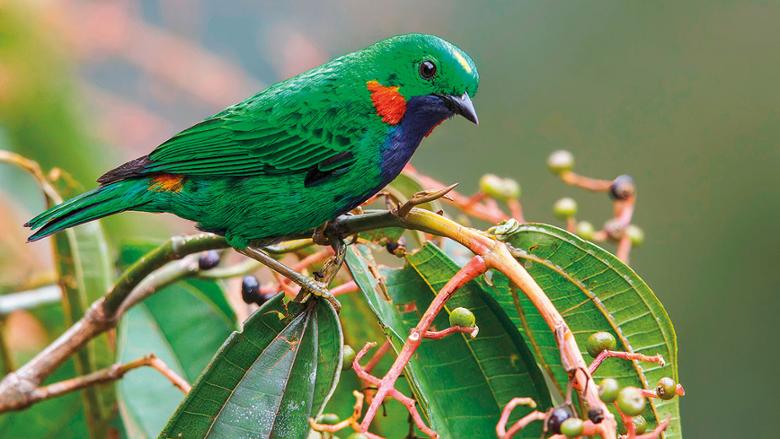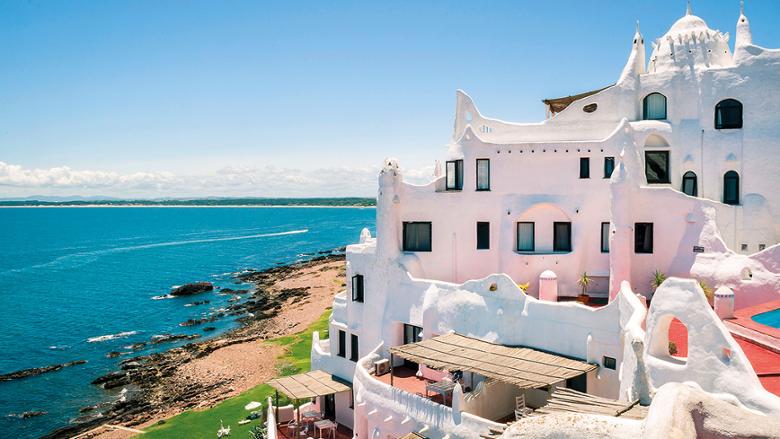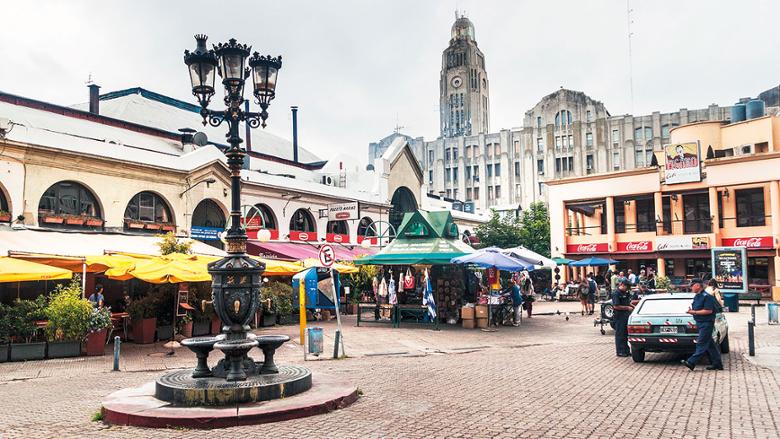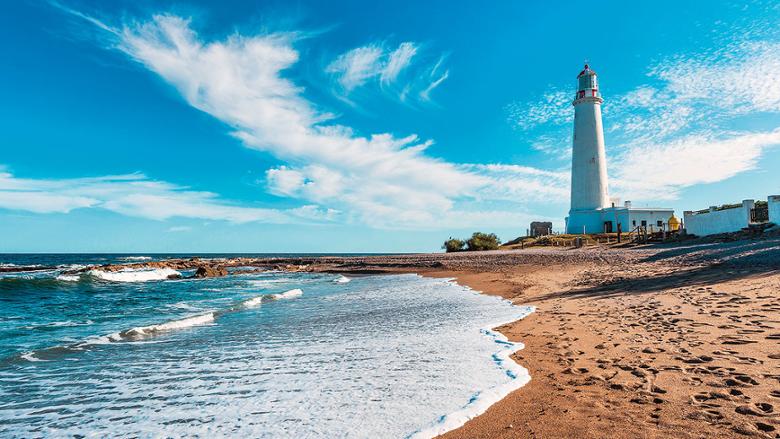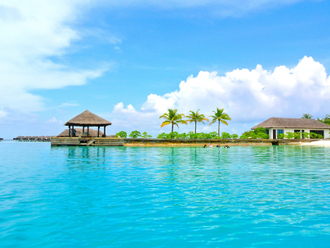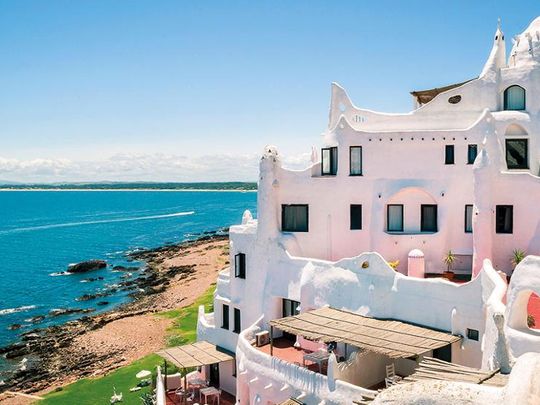
Ecuador and the Galapagos Islands
Arguably the origin of The Origin of Species – and the place to see them
In August, Quito hosted Sal Quitena, its first food festival, complementing the year-round roster of arts and music events. Perhaps the capital most devoted to tourism, the competitive streak hasn’t taken away its charm. An odd mix of indigenous markets, trendy hostels and eateries, and dashing social-cum-artistic statements like the Capilla del Hombre (Chapel of Man), it’s a bustling little city.
A short drive takes you to the Avenue of the Volcanoes – soaring crater-topped summits, some active, some dormant – which in turn lead into the Amazon, or to the Cloud Forest of the globally important Choco-Darien bioregion. Here, glass-walled, gloriously isolated Mashpi Lodge continues to expand its activities with the Mashpi Centre, where guests get to work alongside resident biologists on surveys of butterflies, amphibians, reptiles, bees and wasps.
From Quito, it’s a 90-minute flight – stopping at steamy Guayaquil – to Isla Baltra in the Galapagos. Sensitively managed, the islands are best accessed on a small ship or yacht cruise. Low-impact trails and swimming sites allow close contact with land and marine iguanas, giant tortoises, green sea turtles, flightless cormorants and reef and hammerhead sharks.
Those who want a slower, more settled experience can stay over at properties such as Scalesia Lodge on Isla Isabela, a luxurious safari-style tent resort set in 40 acres of coastal forest.
On September 4, the La Cumbre volcano on uninhabited Fernandina blew its top for the first time in eight years. This doesn’t affect travel, except that cruise passengers may catch sight of further eruptions.
Don’t miss: Quito, Avenue of the Volcanoes, Galapagos Islands.
How to do it: Exodus (exodus.co.uk) has a 15-day Avenue of the Volcanoes group tour that combines five days’ walking, including a trek in the highlands of the Cotacachi-Cayapas Reserve, and five days’ ice-climbing skills - suitable for beginners. Departure: Nov 18.
Wexas Travel’s (wexas.com) 13-day tailor-made journey starts in Quito, transferring to the Galapagos Islands to embark on a yacht cruise. As well as the wildlife, there are stays at the Finch Bay Hotel on Isla Santa Cruz and Scalesia Lodge.
Guyana, Suriname and French Guiana
Hardly anyone in South America has been – join the exclusive travel club
The undiscovered countries of the Americas, the three “Guianas” are small nations tucked in to a corner between Venezuela and Brazil, with Caribbean coasts to the north, and the southern swathes delimited by the Guiana Shield, sometimes dubbed “the greenhouse of the world” for its unspoilt, species-rich jungles.
Guyana, formerly a British colony, has a rough and ready capital, Georgetown, and some of the best jungle retreats in the region in the Atta Rainforest Lodge and Iwokrama River Lodge. With Venezuela off-limits due to instability, waterfall-baggers should visit the Kaieteur Falls – the world’s tallest single-drop fall, in its namesake national park.
Suriname was retained by the Netherlands in exchange for Britain taking control of New Amsterdam – aka Manhattan – back in 1667. OK, Britain won that one. But, while the greenery on the US islet has been razed to the ground, Suriname is a tantalisingly wild and beautiful land. Capital Paramaribo is immaculately preserved, with Unesco-listed Dutch colonial, mainly wooden, civic buildings, hip coffee shops and a lovely riverside dining area. Inland is a vast jungle and labyrinthine network of rivers.
The most beguiling of the three is probably Guyane/French Guiana, a French Overseas Department, with a sizeable Foreign Legion (who do their jungle training here) and the Guiana Space Centre north-west of Kourou.
Cayenne, the capital, is a romantic little city. The real highlights of French Guiana, though, take the form of “dark tourism”: the atmospheric ruins of Saint-Laurent-du-Maroni, the arrival port for prisoners, and the grimly thrilling penal colony of the Iles du Salut, the most famous of which is Devil’s Island.
Don’t miss: Cayenne, Devil’s Island (in French Guiana); jungle stays and wildlife safaris (in Guyana); Paramaribo (in Suriname).
How to do it: Explore’s (explore.co.uk) new 12-day Backwaters of Guyana Expedition includes a seven-day journey paddling dugout canoes on Guyana’s Burro Burro river, spotting macaws, otters, tapir and agouti, and sleeping in hammocks in the jungle.
Steppes Travel (steppestravel.com) offers a 15-day itinerary taking in Guyana, French Guiana and Suriname. This trip takes in the wildlife, Amerindian culture and colonial history of the three Guianas and a visit to the space centre.
Paraguay
Landlocked, low-lying, steamy and strange – the call of the wild for those who want to get off the tourist trail
South America’s most unsung destination can’t offer the lush landscapes, luxury lodges or modern infrastructure of its larger neighbours. What it does have is authenticity. Travel from the stirring Jesuit Missions of the south via Asuncion and on into the Chaco, the low-lying wilderness west of the capital, and chances are you’ll not meet another gringo.
The missions of La Santisima Trinidad de Parana and Jesus de Tavarangue were inscribed as Unesco World Heritage sites back in 1993. However, only vestiges remain. Just to the north, Santa Maria de Fe is a pretty, peaceful hamlet that gives visitors a living impression of how life might have been in the olden days. The central plaza has preserved its character and a small museum of carved saints is testament to the artisanal skills of the Guarani.
Asuncion is the opposite of pretty, but it does have pleasant avenues and two excellent museums: the Museo del Barro, which brings together centuries of native and colonial art and craft; and the volunteer-run Museo de las Memorias, reminding Paraguayans of the exploits of former dictator Alfredo Stroessner. Nearby Lake Ypacarai is a tranquil place to spend a day, while – this being Paraguay – seeing the hotel where proto-Nazi Bernhard Forster (husband to Elisabeth Nietzsche) hatched his insane plans for an Aryan settlement, got drunk and died.
North and west of the capital lie two immense wildernesses. The Chaco is an alluvial depression covered in scrubby forest that will delight birders and also hosts a Mennonite outpost. The Paraguayan Panatanal is a wildlife-rich wetlands, best reached by boat (very slowly) or small plane.
Don’t miss: Jesuit Missions, Santa Maria de Fe, the Chaco, Asuncion.
How to do it: Chimu Adventures (chimuadventures.com) can arrange a six-day guided taster tour of Paraguay, including Asuncion, Yaguaron, with its baroque church, Jesuit sites, Monday waterfalls and South America’s largest dam – Itaipu.
Peru
The seat of two great empires: drink and dine like an Inca, sleep and hike like a conquistador
It’s no longer controversial to say Machu Picchu is not Peru’s most exciting destination. The Inca citadel remains one of the wonders of the world – but getting there is, to be honest, rather more exciting.
The opening of the Explora Sacred Valley in Urquillos has given visitors to Peru the best of all excuses to loiter in the region. The hotel offers guests a menu of 20 “explorations”, including hikes, bike rides and drives – many involving Inca sites and, because the valley is still the heartland of the indigenous Quechua people, cultural encounters. The continued expansion of the luxury hotel scene in Urubamba (the valley’s commercial hub) and the plan by Lima’s top chef, Virgilio Martinez, to open a restaurant beside the Moray ruins looks set to make the valley ever more popular.
It’s worth reasserting that Peru’s capital is the undisputed culinary powerhouse of South America: for daring, for vitality and for honouring their indigenous forebears’ produce and dishes, Lima’s chefs stand alone. Stops at pioneer Astrid y Gaston, plus El Mercado, Maido, Malabar and Rafael – as well as Martinez’s top-rated Central – are highly recommended. Book well before you fly. (Get a preview in Dubai: Martinez’s restauarant Lima is in City Walk.)
Alternative ancient sites are luring hikers and history-lovers away from Machu Picchu. In April 2017, a cable car opened between Nuevo Tingo and the pre-Inca ruins of Kuelap in the southern Amazonas region. The site was previously only accessible via a steep 9km drive or four-hour hike up unpaved roads. The 20-minute ride opens up an impressive walled settlement built by the Chachapoyas in the sixth century.
Home to about 1,800 bird species – including 107 endemic species – Peru is realising its potential as a birding holiday destination. Lodges such as the family-owned Tambo Blanquillo in Manu National Park, north of Cusco, and Tambopata Research Centre and the new Inkaterra Guides Field Station – accessed via Puerto Maldonado – employ experts and offer guests a combination of up-close nature and comfort.
For train buffs, the new Belmond Andean Explorer is a luxury sleeper supplementing the same firm’s Hiram Bingham Cusco-to-Machu Picchu Pullman-style service. Well-heeled travellers can now go to Puno and Lake Titicaca as well as Cusco, feasting on fine food and staying in double-bed cabins; the train even has a spa car.
Pope Francis visits Peru from Jan 18-21, and is scheduled to say Mass in Lima, Trujillo and Puerto Maldonado.
Don’t miss: Sacred Valley, Kuelap, Lima, Manu National Park, Cusco.
How to do it: Martin Randall’s (martinrandall.com) 16-day Andean Heartland guided group tour of Moche, Chimu and Chachapoya sites also includes on-site stays at Machu Picchu.
Llama Travel’s (llamatravel.co.uk) 13-day Incas & Conquistadors of Peru tour visits Lima, Cusco and Titicaca and includes an overnight trip on the Belmond Andean Explorer.
Uruguay
See a whole country in a week, or perhaps not – this is, after all, South America’s answer to slow travel
This diminutive nation has been in the news lately for its laconic ex-president and liberal values.
Capital Montevideo is an emerging destination. Its Sofitel-run Carrasco hotel, summer carnival (Jan-Feb), atmospheric port market and Afro-Latin population and laid-back pace make it feel very different from Buenos Aires – across the river, and connected by fast ferry.
Uruguayans are justly proud of their farming and cattle-rearing history. Inland from the River Plate it’s easy to get to an estancia for horse riding, a barbecue and birding on the pampas. The wreckage of the Fray Bentos meat factory was made into a Unesco World Industrial Heritage site in 2015.
The Atlantic coast is overloaded with ambitious boutique hotels, fad-hungry restaurants and posers’ pads. Bypass Punta del Este (mobbed by Argentines late Dec-Mar) and aim for smart but attractive Jose Ignacio, or continue north to mellower La Paloma and Cabo Polonio (the latter is great for camping).
Don’t miss: Montevideo, La Paloma and the northern Atlantic coast, Fray Bentos and the Uruguayan Pampas.
How to do it: Last Frontiers’ (lastfrontiers.com) 10-day Classic Uruguay itinerary combines Montevideo, Colonia, a beach posada in Jose Ignacio and Fray Bentos.
For more travel ideas and more than 275 tour operators and service providers, see the website of the Latin American Travel Association (lata.travel).


